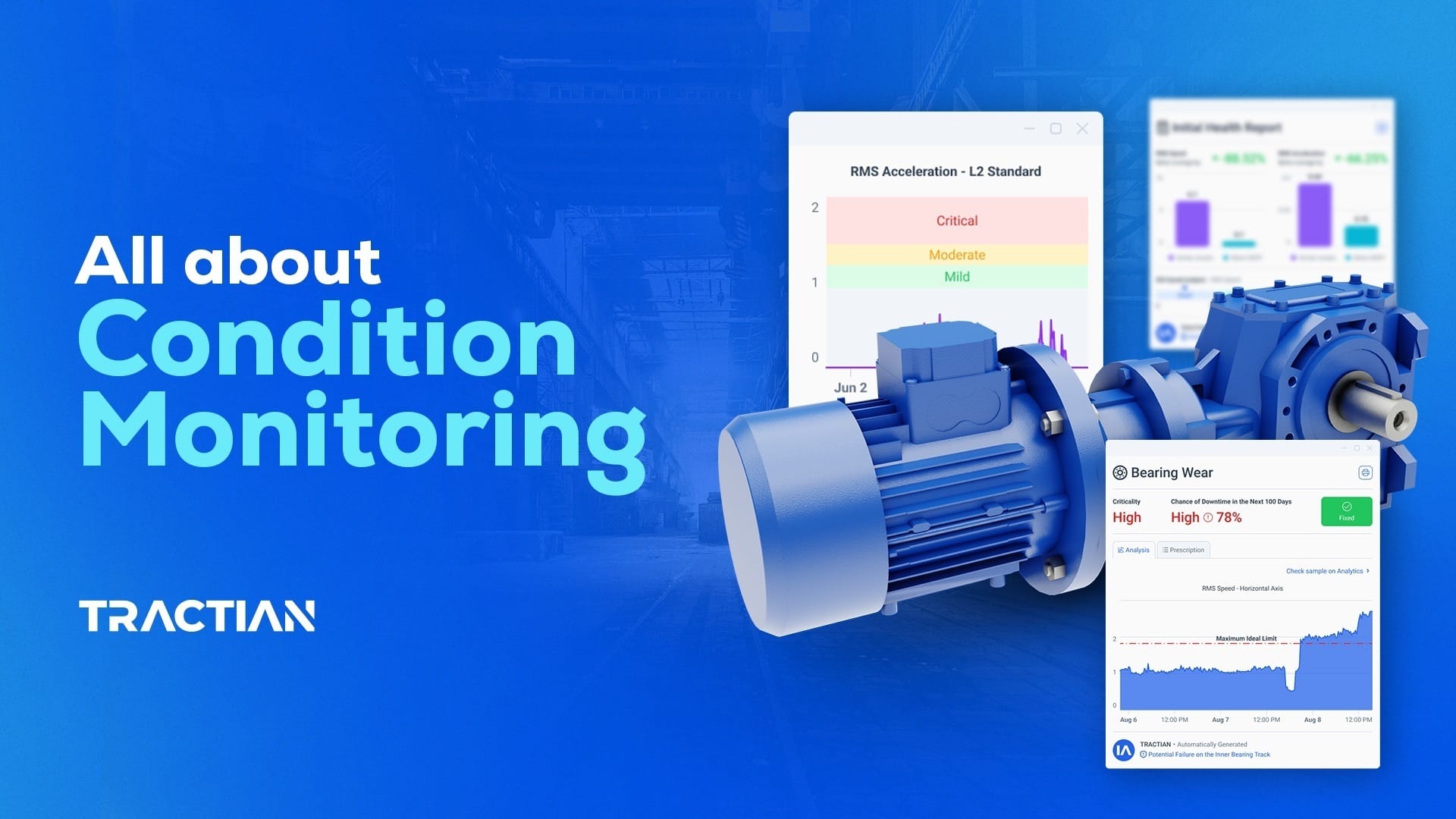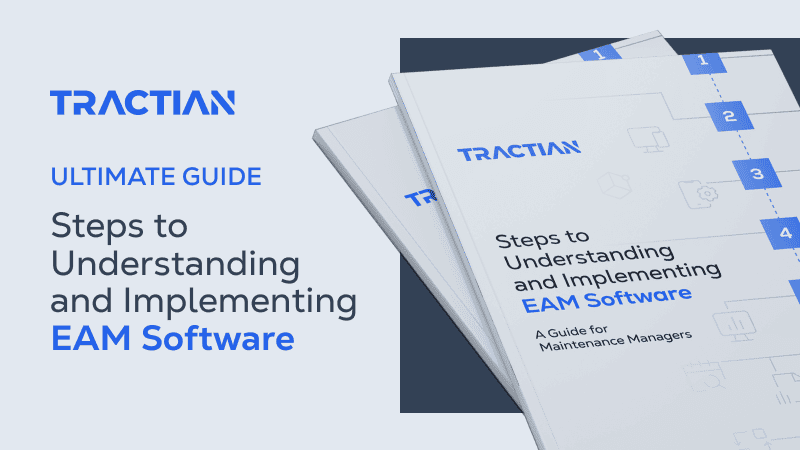Condition monitoring, also known as condition-based monitoring, condition-based maintenance, or CbM, is a strategy used in machine maintenance allowing the maintainer to monitor assets and their conditions. Using condition monitoring enables you to assess the current health, degradation, and any relevant changes to your machines, in turn helping to avoid machine failures and cut out unplanned downtime.
In this piece we’ll cover the types of CbM, how it works, why you should be implementing it in your business, and some practical examples.
What Are the Types of Condition Monitoring?
Condition monitoring is considered to be a crucial part of both predictive and preventive maintenance strategies because of the performance data it collects and what that data can reflect.
Machine data is collected in different ways, depending on what type of machine is being assessed. Let’s take a look at the four main condition monitoring techniques in use today:
Acoustic Emission
All machines with rotating parts make sound – it’s when that sound changes you should look for faults. If you can detect changes in those high-frequency emissions, you can catch faults early on. Equipment that uses roller bearings, could have a lack of lubrication, or that may have bad seals can especially benefit from acoustic emission condition-based monitoring.
Thermography
With moving parts comes heat, and any change in temperature within a machine can indicate an issue. You can monitor for hot spots and cool spots to prevent overworking a machine, thus helping to prevent downtime. In thermography, radiation is detected in the form of heat coming off of an object – much like thermal imaging you’ve seen, or thermograms.
Oil Analysis
Machine lubricant, or oil, can contain debris, and that debris can wear down your machine. Analyzing the debris can help you correct other machine faults before they become failures. Oil analysis is often used in motor vehicles, but instead of only changing the oil when absolutely necessary, condition-based monitoring helps to predict strange debris or particles prior to a problem.
Vibration Analysis
Rotating parts vibrate, and those vibrations can fluctuate. Using vibration analysis in predictive maintenance strategies alongside machine learning allows you to understand the exact patterns for each machine, enabling you to predict when problems will arise before they become faults.

Although all types of condition monitoring can and will work in harmony, vibration analysis is the most popular – and accurate – of them all. Vibration monitoring is most commonly used in machines that have rotating pieces, bearings that sustain wear, and those that may leak. It’s an easy way for maintainers to detect degradation, imbalances, misalignments, and many other fault modes in machines to avoid future failures and unplanned downtime.
Elevate Machine Health with Precision Monitoring
How Does Condition Monitoring Work?
Condition monitoring, at its core, uses different methods of analysis to monitor the condition or performance of a machine. The data collected from these analyses then uses the “four pillars” to implement the strategy, and from there you’re able to make future maintenance predictions. These four pillars are essentially the steps you’ll follow when implementing any condition-based monitoring system.
How Do You Implement Condition Monitoring?
The implementation of condition monitoring directly follows its four pillars: detection, diagnosis, prognosis, and programme.
- Detection details the “when” of the machine fault. This includes when the issue may have started, how early it was noticed, and how long it has to be tended to until it turns into a failure.
- Diagnosis focuses on the “what” of the fault. In this step you will focus on the origin of the issue, what stage it’s at currently, how fast it’s growing, and any machine parts that may be or have been affected.
- Prognosis is the step where you forecast the aftereffects of the fault. This is when you’ll estimate the severity of the issue, look at possible results and production loss it can cause, as well as all of its side effects.
- Programme is all about the schedule of the repair. You’ll decide when machines need to be taken for maintenance or repair, decide on a maintenance policy, and make a timeline for the correction and when it can be finished.

These four pillars are the functional aspect to implementing any condition monitoring strategy, and should be followed in every instance necessary.
Why is Condition Monitoring Important?
As a whole, condition monitoring is an increasingly important strategy for machine maintenance teams to utilize in their day to day operations. First and foremost it’s about the maintenance teams – the Maintainers – being able to make informed decisions about both the performance and maintenance of the machines.
Outside of being useful for the Maintainers, condition monitoring allows companies to collect and analyze data needed to improve machine performance, assure long-term asset health, and continue to better their own maintenance processes.
Why Should You Use CbM in Machine Maintenance?
Avoid unplanned downtime? Catch faults before they become failures? Detect machine issues before they even become a fault? Condition monitoring strategies seem like a no-brainer when it comes to predictive and preventive maintenance.
Smart Trac, TRACTIAN IoT sensor, is a good alternative. It listens to each piece of equipment, evaluates the condition of the machines in real time, and collects information about everything that is happening and can still happen.
Collecting vibration, temperature, and hour meter data allows you to understand the asset’s behavior, and thus develop specific strategies for its operation, extending the useful life of parts and equipment.
The sensor not only detects when something is wrong at the slightest sign of failure. After data analysis, the condition monitoring platform sends automatic, prescriptive alerts about each failure mode, and arms maintenance managers with practical solutions and courses of action to solve the problem.
TRACTIAN fault detection technology has been granted a patent by the world’s leading patenting institution; learn more here.
Tractian’s condition monitoring system alone learns asset behavior, anticipates failures, and prevents breakdowns and downtime. However, when coupled with the maintenance management software, CMMS TracOS™, it becomes a complete and integrated ecosystem that can be accessed on a single platform with full mobility – through the computer browser or the TRACTIAN App on tablets or smartphones.
With TracOS™, the maintenance team and managers direct all activities in a single platform that creates work orders, generates maintenance plans, calculates and updates key indicators – and does it all automatically. In addition, the software integrates with SAP and other traditional market ERPs to give more mobility and predictability to the team.
With state-of-the-art technology and resources developed with maintainers in mind the goal of TRACTIAN is to make maintenance professionals’ work less stressful through hardware and software tools that make them the best in their category.
If you’ve been looking for a solution to your machine maintenance woes, look no further. Schedule a demo with one of our experts today!


